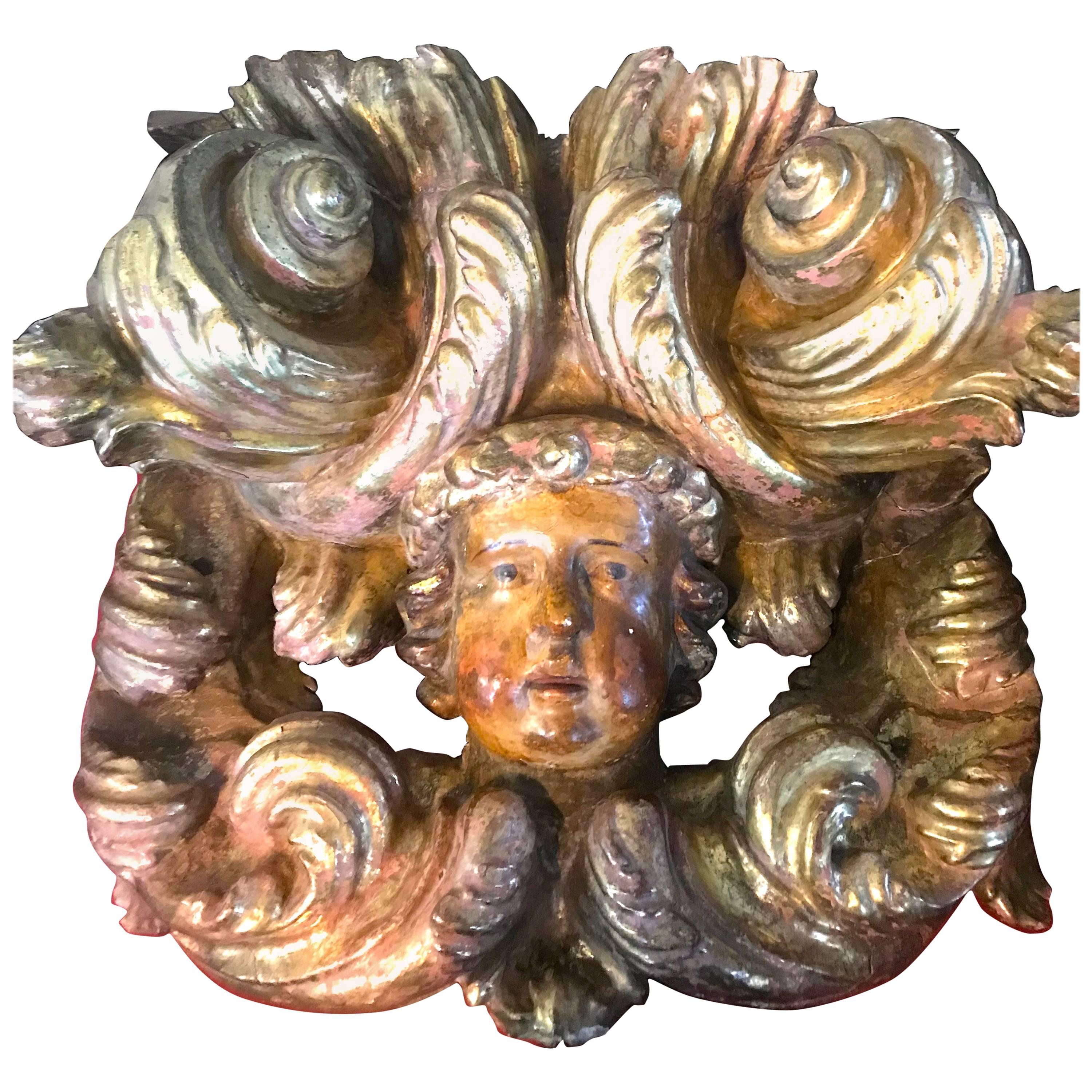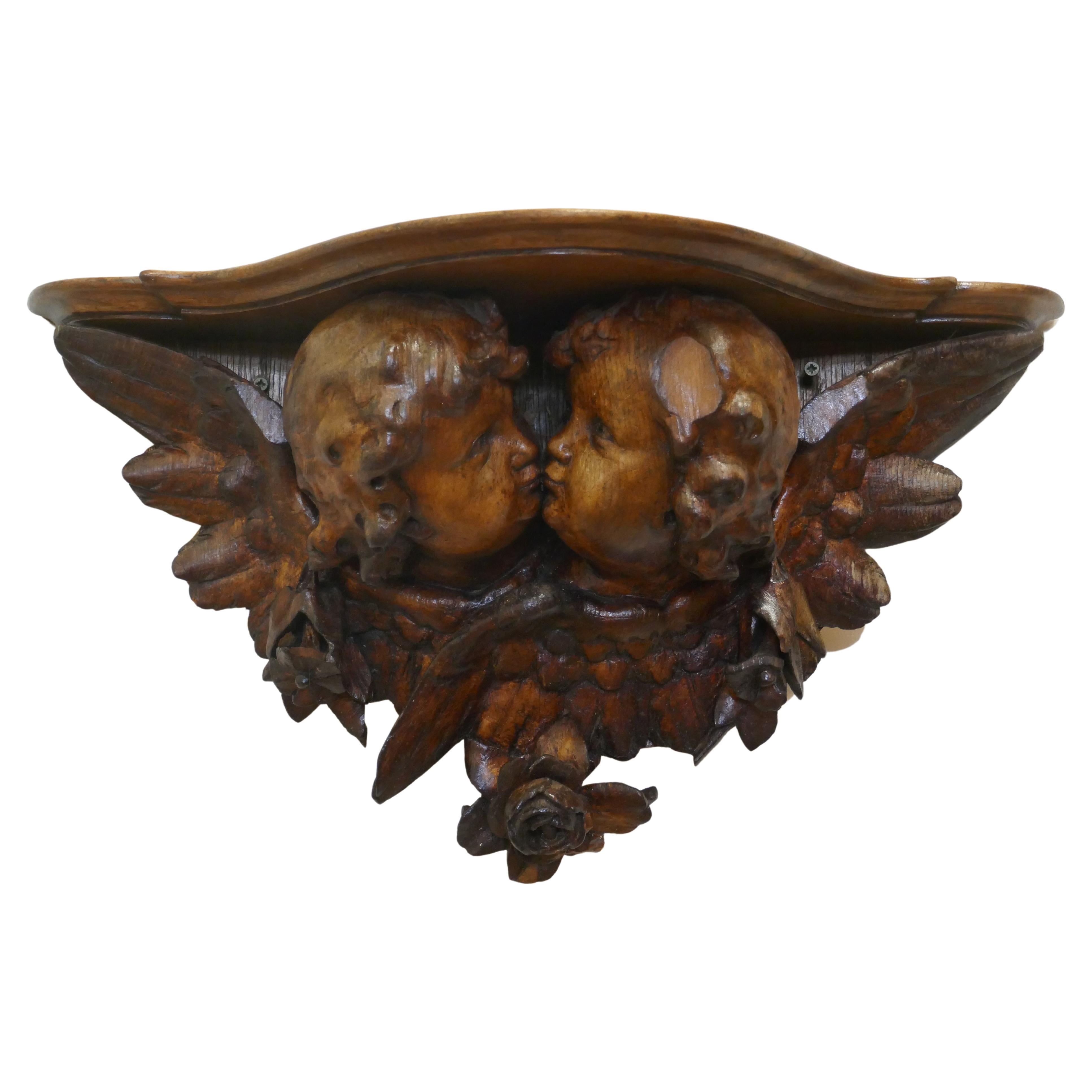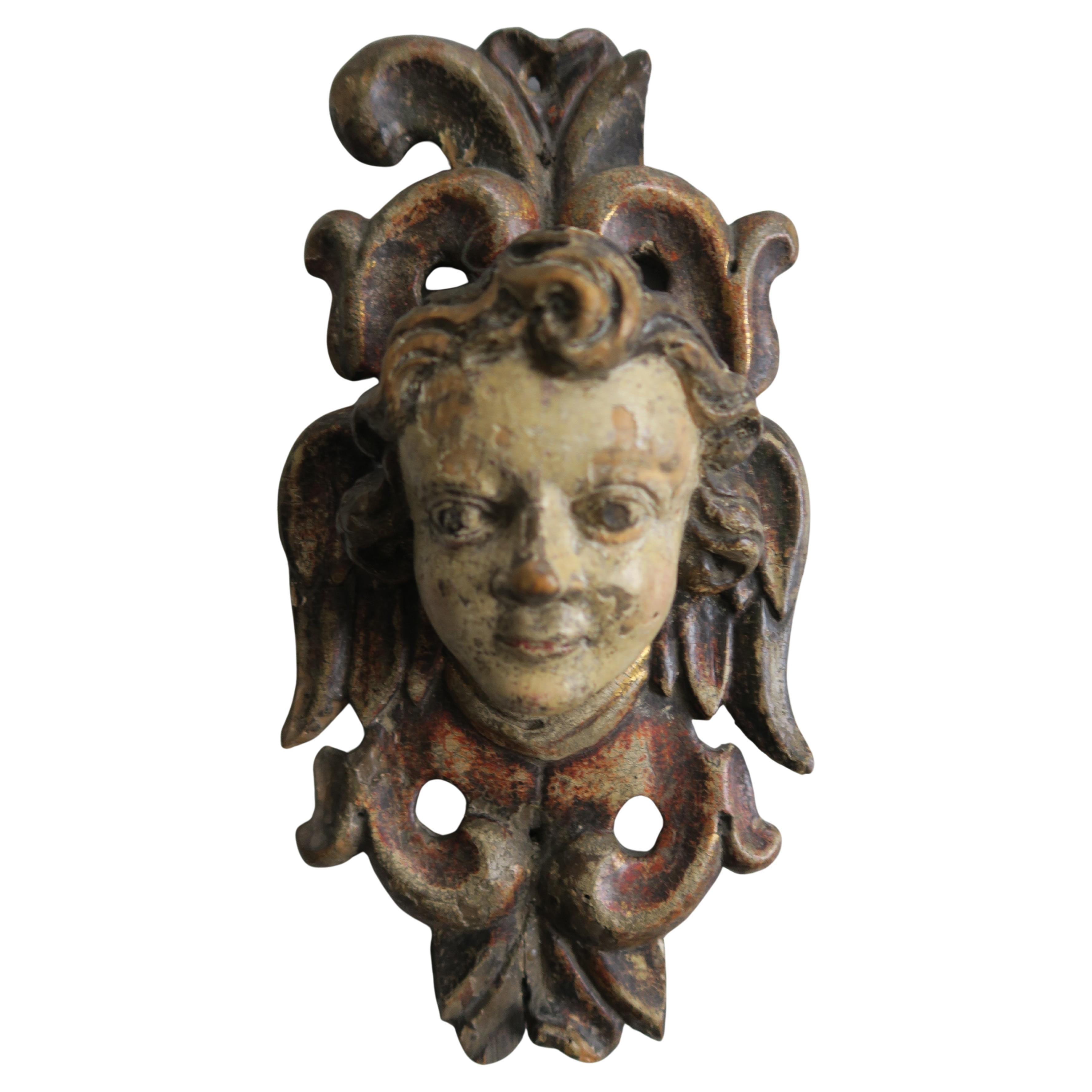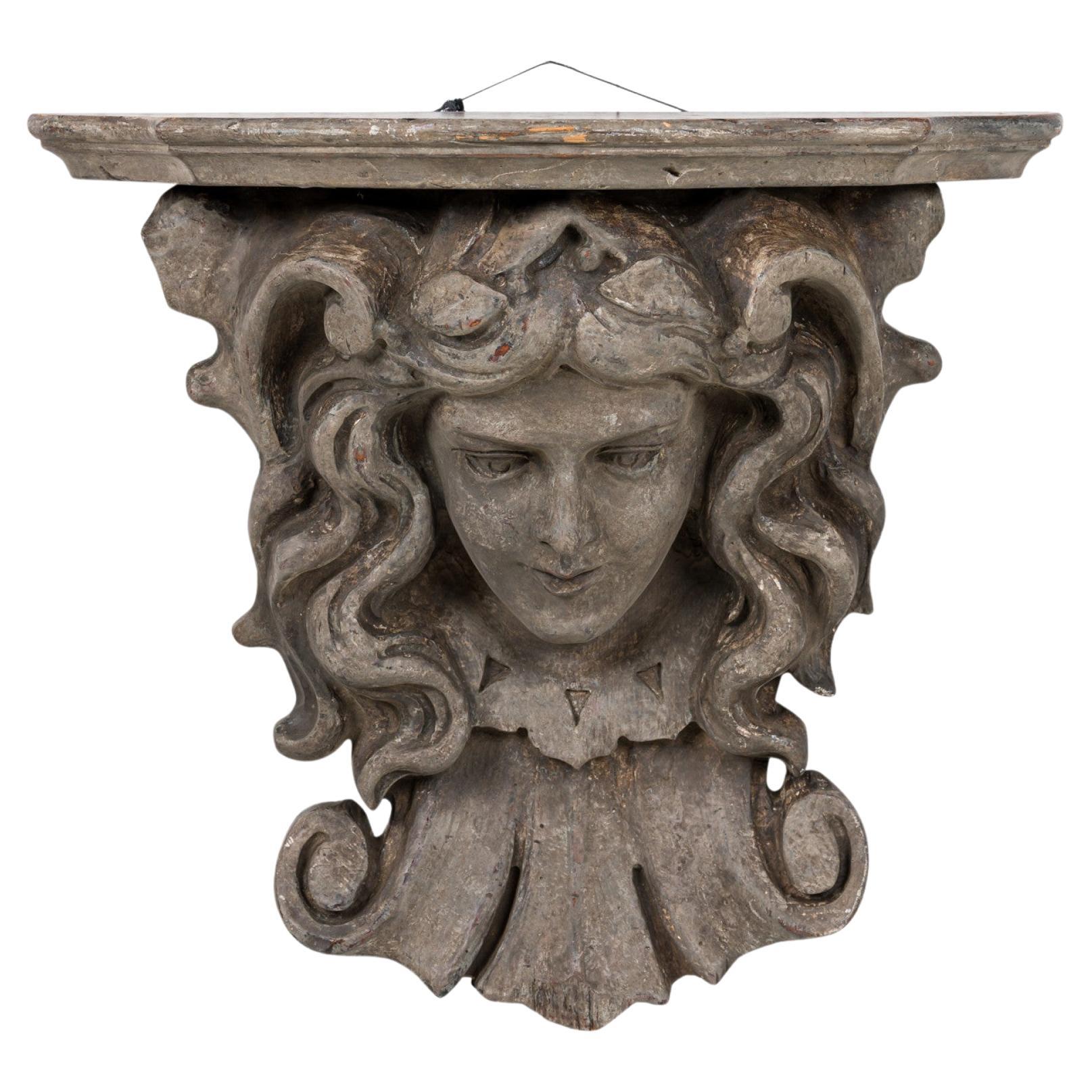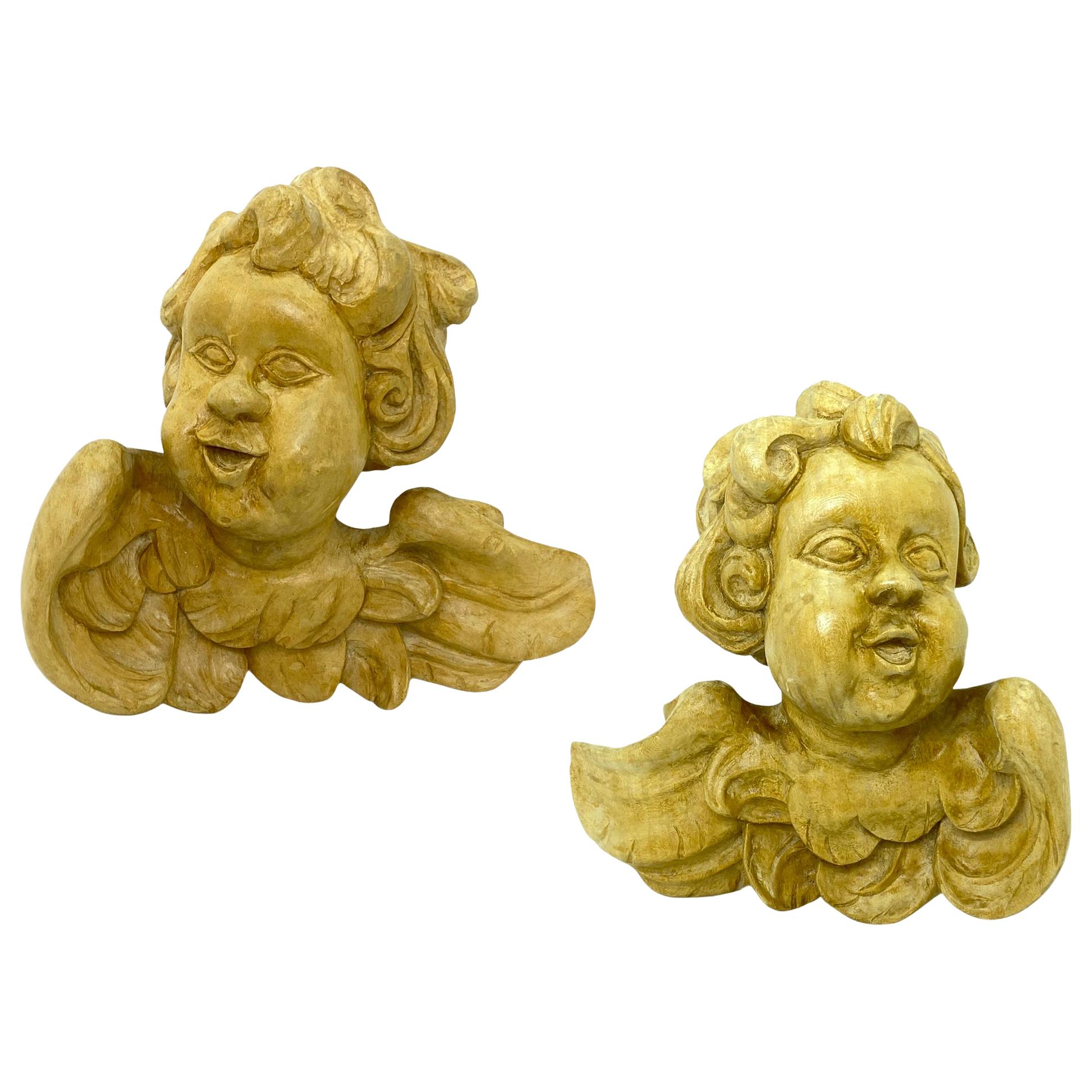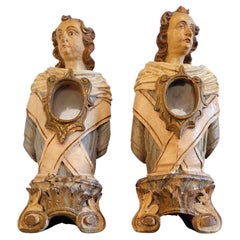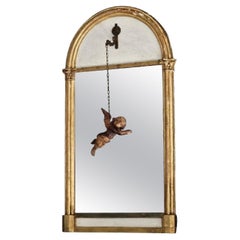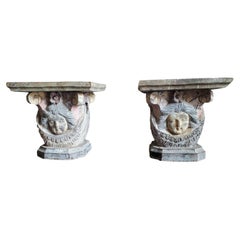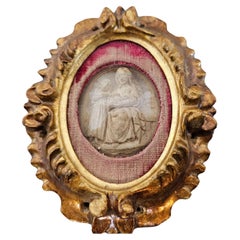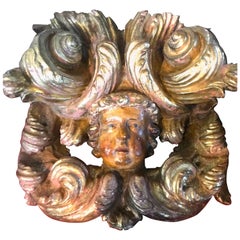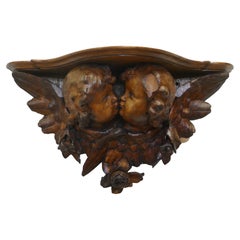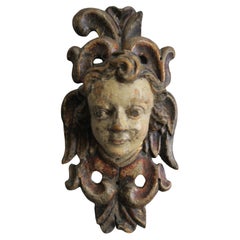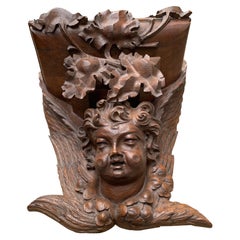Items Similar to 18th Century German Baroque Architectural Putti Bust Wall Shelf Carving
Want more images or videos?
Request additional images or videos from the seller
1 of 21
18th Century German Baroque Architectural Putti Bust Wall Shelf Carving
$1,250
£944.55
€1,093.24
CA$1,753.69
A$1,950.60
CHF 1,023.28
MX$23,801.81
NOK 12,843.51
SEK 12,103.45
DKK 8,160.55
About the Item
A finely carved Baroque period architectural element, now fashioned as a sculptural bracket shelf.
Hand-crafted by a master-artisan in the 18th century, originally part of a corbel, likely from a church around the Black Forest region of Southern Germany. Exquisitely hand carved solid walnut, exceptionally executed and intricately detailed, featuring two protruding busts of cherub children with fine facial details and sculpted wavy hair, over pierced foliate floral decoration. circa 1750
Provenance / Acquisition:
Property from the magnificent estate of the late T. Boone Pickens (1928 -2019). An American business magnate and financier.
Acquired from the highly reputable auction house J. Garrett Auctioneers, Dallas, Texas. September 2022 More of T. Boone Pickens Estate catalog
J. Garrett Auctioneers had the pleasure of presenting this item from the iconic Texas and Oklahoma oil tycoon, T. Boone Pickens' estate.
The breadth of T. Boone Pickens' career is impressive. He built one of the largest independent natural gas oil companies in the United States and flourished as an entrepreneur thereafter, generating hundreds of billions of dollars in the process. Among his lengthy accolades, Time magazine has identified him one of its "100 Most Influential People", Financial World named him "CEO of the Decade" in 1989, and Oil and Gas Investor identified him as one of the "100 Most Influential People of the Petroleum Century."
Dimensions: (approx)
8" High, 7" Wide, 8.75" Deep
Condition Report:
Great antique condition, especially considering its age. Nicely aged warm rich dark rustic patina, later shellacked surface, wear consistent with age and use, including age related shrinkage fissure. Later metal wall hanging mount to verso.
A wonderful example of Baroque period European folk art, the antique architectural salvage building ornament repurposed as a decorative wall sculpture - candle shelf, is sure to add sophisticated elegance, whimsical rustic warmth, and classic style, as well as rich cultural and historical interest to any space!
- Dimensions:Height: 8 in (20.32 cm)Width: 7 in (17.78 cm)Depth: 8.75 in (22.23 cm)
- Style:Baroque (Of the Period)
- Materials and Techniques:
- Place of Origin:
- Period:
- Date of Manufacture:circa 1750
- Condition:Wear consistent with age and use. Great antique condition, especially considering its age. Nicely aged warm rich dark rustic patina, later shellacked surface, wear consistent with age and use, including age related shrinkage fissure. Later metal wall hanging mount to verso.
- Seller Location:Forney, TX
- Reference Number:1stDibs: LU5977238710122
About the Seller
4.8
Platinum Seller
Premium sellers with a 4.7+ rating and 24-hour response times
Established in 2013
1stDibs seller since 2021
295 sales on 1stDibs
Typical response time: <1 hour
- ShippingRetrieving quote...Shipping from: Forney, TX
- Return Policy
Authenticity Guarantee
In the unlikely event there’s an issue with an item’s authenticity, contact us within 1 year for a full refund. DetailsMoney-Back Guarantee
If your item is not as described, is damaged in transit, or does not arrive, contact us within 7 days for a full refund. Details24-Hour Cancellation
You have a 24-hour grace period in which to reconsider your purchase, with no questions asked.Vetted Professional Sellers
Our world-class sellers must adhere to strict standards for service and quality, maintaining the integrity of our listings.Price-Match Guarantee
If you find that a seller listed the same item for a lower price elsewhere, we’ll match it.Trusted Global Delivery
Our best-in-class carrier network provides specialized shipping options worldwide, including custom delivery.More From This Seller
View All18th Century Italian Carved Painted Wood Reliquary Altar Figure Bust Pair
Located in Forney, TX
A remarkable pair of scarce large Italian Baroque period carved and painted wood church altar reliquary busts.
Born in Italy in the 18th century / possibly late 17th century, figural form, each hand carved from a single log, modeled as opposing figures, parcel gilt polychrome decorated, hollowed central cavity with original glazed glass relic viewing panel, rising on integral marbleized scroll foot base.
Dimensions: (each)
21.25" Tall, 8.5" Wide, 8" Deep;
16.25lbs Total
Condition Report:
Very good original unrestored antique condition with beautifully aged patina. Wear consistent with age and use, including scattered nicks, chips, and chippy paint losses. One glazed panel with losses to sides. Overall in great shape, strong, sturdy, stable, and structurally sound. Presents splendidly
We here at Lynx Hollow Antiques absolutely love decorating with religious antiques! From an antique altarpiece, tabernacle, reredos, shrine niche, baptismal font, crucifix, santo statue, icon, religious folk art, retablo, monastery table to church architectural elements...
Category
Antique 18th Century Italian Baroque Religious Items
Materials
Blown Glass, Wood
Antique Italian Renaissance Sculptural Carved Giltwood Mirror with Putti Figure
Located in Forney, TX
Add whimsical elegance, sophistication, and romantic warmth with this one-of-a-kind antique Italian Renaissance sculptural floating putti wall mirror enhanced by beautifully aged war...
Category
Antique 19th Century European Baroque Wall Mirrors
Materials
Brass
19th Century Baroque Carved Polychromed Architectural Column Capital Table Pair
Located in Forney, TX
An early 19th century pair of Baroque hand carved and painted wooden architectural salvaged exterior building elements, now repurposed and fashioned for use as one-of-a-kind pedestal tables.
Intricately detailed, whimsical sulptural design, executed in classical corinthian column capital form, having spiral scroll volutes, acanthus leaf carvings, figural ancient mask...
Category
Antique 19th Century Folk Art Architectural Elements
Materials
Wood
Antique Italian Religious Giltwood Reliquary Relief Carved Sculpture
Located in Forney, TX
A rare antique Italian giltwood framed reliquary. 18th/19th century, hand carved giltwood frame housing an exceptional relief carving, d...
Category
Antique Early 19th Century Italian Baroque Religious Items
Materials
Bone, Giltwood
Monumental Antique French Empire Period Hall Pedestal Plant Stand
Located in Forney, TX
A magnificent over 200 year old French Empire Period (1804-1815) parcel gilt walnut armorial hall pedestal / plant stand.
Born in France in the early 19th century, most likely near the Italian border or Napoleonic territory in present day Northern Italy, most impressive palatial scale, exceptionally executed one-of-a-kind sculptural work, having carved fiolate apron with H monogram, decorative scroll work, stylized grotesque satyr mask with acanthus leaf accent, over high relief crest mural crown depicting four towers representing fortified city walls, shield escutcheon coat of arms with three fleur-de-lis above wavy lines depicting sea water in front of castle tower, supported by figural winged female caryatid, flanked by volute supports, joined by turned stretcher. circa 1810
Provenance / Acquisition:
An important San Antonio estate
Acquired from highly reputable auction house Austin Auction Gallery, est.1983, Austin, Texas. Texas Mansion Carved French and Italian Antiques catalog...
Category
Antique Early 19th Century French Empire Planters and Jardinieres
Materials
Walnut
1920s American Art Deco Ronson Cherub & Butterfly Patinated Bronze Bookend Pair
By Ronson Art Metal Works
Located in Forney, TX
A fabulous pair of high-quality patinated bronze American Art Deco period bookends by Ronson Art Metal Works, circa mid-1920s, #7072, tilted "Cherub And Butterfly".
Created in the early 20th century, the beautifully detailed works depict sculptural high relief figures of classical winged cherub putti seated among leaves, each enchanting putti holding a closed book, while their raised hands grasp butterflies. The naturalistic base with floral vines and a frog on each, backing to large book form, detailed book bindings with elegantly aged dull gilt finish, and green felt covered bases.
Provenance / Acquisition:
A fine and magnificent private estate in Greenwich, Connecticut
Acquired from the reputable auction house Blackrock Galleries, Greenwich, Connecticut
Maker:
Ronson's Art Metal Works, founded by Louis V. Aronson (1869-1940) in the 1800s, was a leader and pioneer in the manufacture of fine decorative metalwares into the 1930s, producing a diverse selection of beautifully designed bookends, figural lighters, hood ornaments, figurines, lamps, and more.
Dimensions: (approx)
6.5" High, 4.5" Wide, 4.5" Deep (each)
History:
Louis Aronson while still a student in the mid 1880s, registered his first patent for the electroplating of metal. In 1886, he sold his patent, raising $5,000, to start the Art Metal Company in New York City. The following year, he moved the company to Newark, NJ and changed the name to Art Metal Works.
Ronson is best known for cigarette lighters, he invented the “safety match” in 1897, and the first mechanical cigarette lighter in 1910. But it was throughout the 1920s and 1930s, Ronson Art Metal Works became one of the most prolific and creative of all artistic bookend producers. In 1915, he copyrighted his first pair of bookends, and by 1936 had over 150 copyrighted bookends in his company catalog. By 1928 the company was traded on the American stock exchange...
Category
Early 20th Century American Art Deco Bookends
Materials
Bronze
You May Also Like
Huge Italian Baroque Carved Cherub Head Putti
Located in Godshill, Isle of Wight
An Italian Baroque carved and polychrome- painted winged cherub head putti
This is a wall hung carved and polychrome painted wall mask in the form of a cherub set in the middle of...
Category
Antique Mid-18th Century Baroque Wall-mounted Sculptures
Materials
Wood
19th Century Carved Wood Cherub Wall Bracket
Located in Godshill, Isle of Wight
19th Century Carved Wood Cherub Wall Bracket
This is a beautifully carved piece, depicting 2 kissing Putti or Cherubs, showing their wings at ...
18th Century Baroque Wood Carved Angel Head
Located in Kiel, SH
A wood carved baroque angel in old paint with wings 18th century
There is a part missing, see pictures, and some wear due to age and use to the paint.
Category
Antique Late 18th Century European Baroque Figurative Sculptures
Materials
Wood, Paint
Extra Large and Museum Quality Gothic Art Bracket Shelf Corbel w Angel Sculpture
Located in Lisse, NL
Amazingly hand carved church wall bracket with a winged angel sculpture.
This stunning and all handcrafted, Gothic Revival wall bracket has the mo...
Category
Antique Mid-19th Century European Renaissance Wall Brackets
Materials
Oak
Italian Rococo Carved Wood Faux Bois Figural Wall Shelf / Architectural Element
Located in Queens, NY
Italian Rococo-style wooden wall bracket / shelf / architectural element featuring a carved face below an upper shelf with carved and shaped beveled edge, treated with a faux bois pa...
Category
Antique 19th Century Italian Rococo Shelves and Wall Cabinets
Materials
Wood
Pair of Hand Carved 20th Century Wooden Cherub Angel Head Vintage, German
Located in Nuernberg, DE
Pair of beautiful hand carved wooden cherub angel head, found at an estate sale in Germany. We believe that this piece is from the mid-20th century. A nice addition to any room. Sign...
Category
Vintage 1960s German Wall-mounted Sculptures
Materials
Wood
More Ways To Browse
Antique Carved Shelf
Antique German 18th Century
Carved Wall Art
Pierced Carving
18th Century Icon
Antique Wall Shelf
Antique Shelf Brackets
German Antique Ornaments
Folk Art Texas
Folk Art Church
Sculpture Wall Shelf
Antique Carved Wall Shelf
Folk Art Shelf
Church Carving
Carving Cherub
German Carved Walnut Antique Furniture
Hand Carved Corbels
Architecture Wall Brackets
